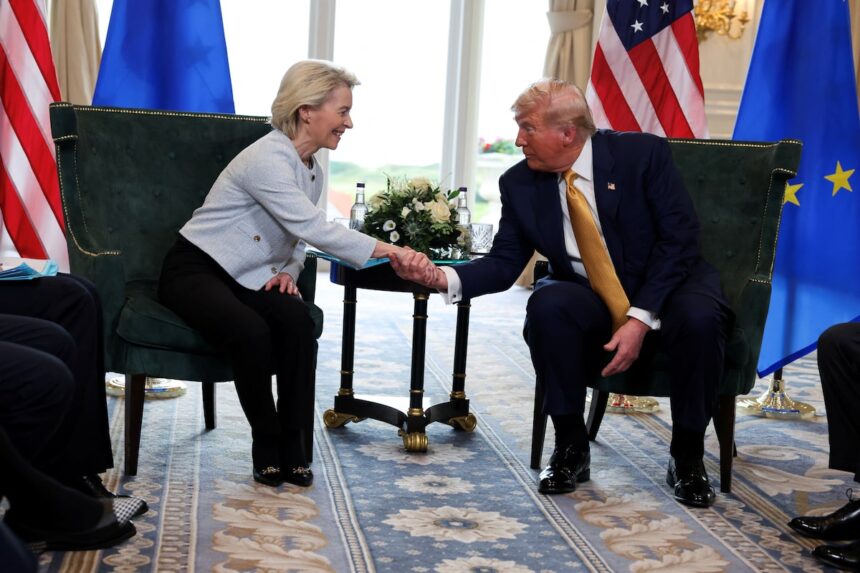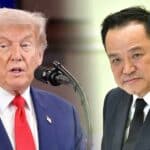WASHINGTON, D.C. – The United States and European Union settled a major trade deal late on Sunday, reaching a deal that sets a 15% standard tariff on most EU products shipped to the US. This agreement prevents an escalating trade conflict between the two sides.
US President Donald Trump and European Commission President Ursula von der Leyen made the deal during direct talks at Trump’s Turnberry golf resort. This outcome highlights the Trump administration’s tough approach to trade while showing the EU’s push to keep strong economic links with its top trading partner, even as the bloc faces ongoing financial pressures.
The two sides settled on a 15% tariff for most EU products arriving in the US, a middle ground between Trump’s earlier threat of a 30% duty and the EU’s push for a 10% cap.
European Commission President Ursula von der Leyen described the outcome as a “huge deal” that followed tough talks. President Trump called it “the biggest deal ever made,” highlighting its importance for the $1.7 trillion trade link between the US and Europe.
What’s in the Trade Deal?
Under the new agreement, most EU exports to America, including cars, microchips, and medicines, will be subject to a 15% tariff. However, some products like aircraft, certain chemicals, and medical devices will not be affected. The existing 50% tariffs on steel and aluminum will stay for now, though von der Leyen suggested they may return to the table in future talks.
The EU also agreed to buy $750 billion in US energy over three years, mainly liquefied natural gas, oil, and nuclear fuels, reducing Europe’s reliance on Russian supplies. A further $600 billion in new EU investments in the US, increased spending on American defence goods, and no tariffs for select US products round out the main points.
Unlike previous attempts such as the Transatlantic Trade and Investment Partnership (TTIP), this deal focuses on stabilizing trade ties rather than removing all barriers. The EU’s proposal to drop tariffs to zero for some products helped secure the agreement, but the finer details are still being worked out. Both parties hope to finalize the paperwork swiftly and avoid any last-minute changes, which have sometimes affected Trump’s past deals.
What Each Side Gains
For the US, the deal tackles Trump’s complaint about the trade gap with Europe. Last year, the EU accounted for $610 billion out of America’s $3.3 trillion in imports. The EU’s pledge to buy $750 billion in American energy and invest $600 billion in the US should boost local industries and create jobs. With a 15% tariff, which is well above the usual 2.2% rate, Washington expects increased revenue.
European companies will now have to absorb some costs or shift them to their customers, possibly making it easier for US businesses to compete. The deal also strengthens America’s position globally, as Europe signals support for buying US military kit and reducing dependence on Russian energy.
For Europe, the outcome prevents steep 30% tariffs that could have hit exports sharply and broken supply chains, especially in Germany’s automotive sector. Germany sent €38.5 billion in cars to America last year. The new tariff, though higher than Europe wanted, is still a manageable compromise.
German Chancellor Friedrich Merz commented that the agreement “avoided a trade conflict that would have badly hurt the German economy,” which depends on exports. Tariffs on German cars have dropped from 27.5% to 15%.
The deal brings greater certainty for businesses and consumers while opening up the US to some EU products at zero tariffs. Italian Prime Minister Giorgia Meloni said the agreement helped avoid a “direct clash” with Washington and protected the EU’s main interests.
Europe’s Economic Pressure
Europe moved quickly to secure the agreement because its economy remains weak. The region has struggled to bounce back since the COVID-19 crisis, dealing with high energy bills, rising prices, and slow growth. Germany, as the EU’s main exporter, has been hit hard by US tariffs on cars and metals.
Volkswagen alone lost $1.5 billion in profits in the first half of 2025 after paying higher US import charges. EU officials say a 30% tariff would have reduced the region’s economic growth by 0.3% in just one year. With Russian energy no longer an option, Europe needs to buy US gas and oil to keep the lights on, making the $750 billion energy pledge essential for both security and the economy.
Trump’s Record on Trade
The EU deal is only one in a series of trade agreements Trump’s team has closed since April. After pausing a planned wave of tariffs, the US struck similar deals with Japan, the UK, China, and Vietnam. Each set baseline tariffs, such as 15% for Japan and 10% for Britain, and won pledges for new spending on US exports and investments.
The Japan deal matched the EU’s 15% tariff, with concessions for Japanese carmakers. Britain received a lower 10% rate. Commerce Secretary Howard Lutnick and Treasury Secretary Scott Bessent have favoured quick, framework deals over thorough treaties, breaking with past US policy.
Trump’s hands-on style helped bring in around $1.35 trillion worth of trade and investment promises, mainly through large pledges from Europe. Still, critics point out that the deals have less legal protection, as they don’t require a vote in Congress, so their future may be uncertain.
The new deal eases tensions for now, but several issues remain. The EU has prepared €93 billion in possible retaliatory tariffs, showing it is ready to respond if Washington acts again. France is pressing for measures to curb US influence, such as targeting American services or limiting US bids in European public contracts.
Trump’s approach to last-minute deal changes, as seen with Canada and Mexico, keeps European officials on alert. The 15% tariff will also raise prices for American buyers, costing households an estimated $1,300 each this year. EU businesses must find ways to stay competitive in the face of higher export charges.
For now, the agreement brings stability to the world’s largest two-way trading partnership, worth €1.6 trillion in goods and services last year. As von der Leyen and Trump continue talks to iron out unresolved issues, like the remaining steel tariffs, the future of US-EU trade is still being shaped. While not perfect, the agreement reflects rare cooperation between the two sides during a period of high economic uncertainty.














